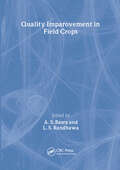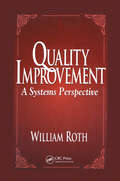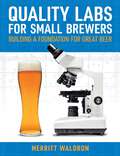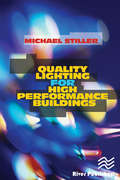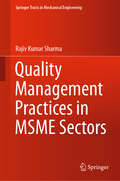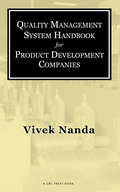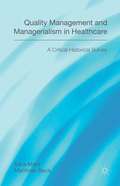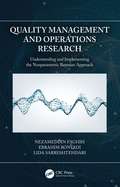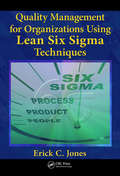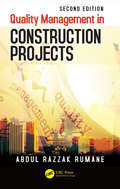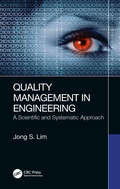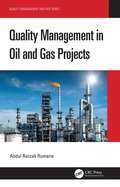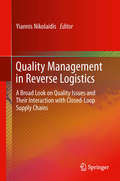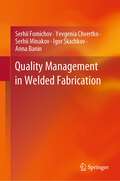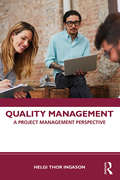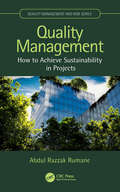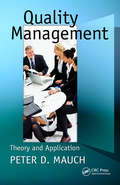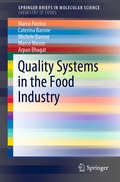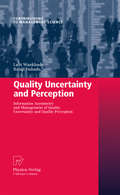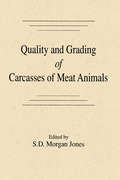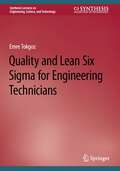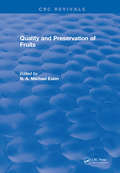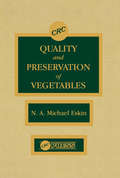- Table View
- List View
Quality Improvement in Field Crops
by Lakhwinder S RandhawaLearn to identify, modify, and manipulate the genes controlling key quality traits in field crops!This informative book provides state-of-the-art information on improving nutritional quality as well as yield volume in field crops such as wheat, maize, rice, barley, oats, lentils, pigeon peas, soybeans, cool season legumes, and crops whose seeds are used to make oils. With contributions from leading authorities in the field, this book will bring you up to date on the uses of agronomic management, conventional plant breeding, and modern biotechnologies in improving the quality of important food, feed, and fiber products.Quality Improvement in Field Crops examines: factors that impact the end-use quality of wheat and ways to improve wheat’s quality for milling and baking agronomic practices that impact the quality of maize ways to improve the nutritional value of rice and legumes techniques for using molecular markers to improve the quality of lentil crops breeding methods that can improve the quality of the oils derived from oilseed crops protein quality/sulfur metabolism in soybeans and much more!This book is dedicated to the World Food Laureate (the equivalent of the Nobel Prize for food scientists), Dr. G. S. Khush--the father of the Green Revolution in rice farming--in recognition of his tremendous contributions to global food and nutritional security for the world?s population.
Quality Improvement: A Systems Perspective
by William RothQuality improvement: it's an attractive concept on paper. So why do the vast majority of quality improvement efforts fail?William Roth knows from experience: as a Ph.D in systems theory, an ex-corporate manager, a professor-and the designer (with the AQP) of a national program to deliver training for quality credentials in the systems approach. His belief: enduring quality improvement is an "all or nothing" situation-requiring a systemic approach, with all the key components and integrations in place and fully integrated right from the start. Quality Improvement: A Systems Perspective explains the sometimes surprising historic roots of the quality improvement movement, and outlines the systems theory on which successful models must be built. Readers then gain access to the hands-on, nuts-and-bolts, how-to-get-it-done details of the five critical phases. Three case studies (two in industry, one in health care) support this traditional but currently shunned model.Along with his unique unified view of quality improvement, Roth explains why it is shunned, and why alternative approaches usually do not produce the desired results. Key obstacles to success are directly identified-top-level management, local union leaders, management education. The ultimate culprit, though, is culture-to which Roth suggests how to move organizations in the right direction, from a systems perspective.With one of the most comprehensive overviews of quality management essentials in one volume, Quality Improvement: A Systems Perspective balances theory and modeling with the details of real-life implementation and success.
Quality Labs for Small Brewers: Building a Foundation for Great Beer
by Merritt WaldronQuality assurance and quality control (QA/QC) is both a system and a state of mind. In Quality Labs for Small Brewers, author Merritt Waldron walks you step-by-step through the process of establishing and writing a quality program for your brewery. Your quality policy should align with your company values and inculcate a quality-first culture throughout your brewery. Building an effective quality program will empower staff to directly influence the consistent production of safe, quality beer from grain to glass.A good quality program has many moving parts but it is underpinned by good manufacturing practice (GMP) and food safety requirements. GMP covers every aspect of a brewery's operation, not just how personnel comport themselves, but how goods in are handled and stored, how beer is held in the warehouse, and how equipment, plant, and the grounds are maintained. Learn how to set standards and critical control points, and how to effectively monitor your process so that any deviation is quickly addressed.Discover how policies, procedures, and specifications can help ensure quality throughout every process. Involve your staff in establishing standard operating procedures, corrective actions, and improvements. Learn how to effectively delegate responsibility and also ensure that management is armed with the information they need to ultimately make what may be some tough decisions. If the worst happens, understand that being able to make a tough call and having a robust recall procedure in place means you can move quickly to rectify matters, which helps your brewery retain the confidence of your customers and distributors.Brewers will see results through the application of GMP and food safety prerequisite programs. Your quality manual laying out standard operating procedures, product specifications, and corrective action plans will give your staff the confidence to implement your quality program. With these programs in place, the author then takes you through each area of your brewery operation and breaks down how key parameters are measured and analyzed at critical control points. Sampling plans are outlined for monitoring density, temperature, pH, yeast viability and growth, alcohol, carbonation, dissolved oxygen, titratable acidity, fill height, and packaging integrity. Explore setting up an effective sensory panel, even a small one, that will help ensure each beer remains true-to-brand. Waldron outlines building your brewery laboratory and looks at how to implement an in-house microbiology program. Throughout this, the focus is on scaling your efforts to the size of your operation and always being ready to expand your quality program as your brewery grows. The author makes it clear that no brewery is too small to implement QA/QC and discusses pragmatic solutions to building out your capabilities.Beyond taking meaningful, accurate measurements, the author also explores how to analyze data. Learn some basics of statistics and data organization and how to apply these techniques to continuously monitor processes and spot when corrective action is needed. These routines will help pinpoint any risks or areas of improvement and ensure that only quality beer reaches the customer, time after time.
Quality Lighting for High Performance Buildings
by Michael StillerThis book provides an overview of the basic concepts of quality, indoor lighting, and explains concepts like visual comfort, visual interest, and integrated design as they relate to the practice of lighting design. Energy-efficient lighting technologies, including LED lighting and digital control systems, and design strategies that increase visual comfort and productivity are discussed in plain language, and examined in a straightforward way to give the reader, whether an architect, interior designer, engineer, building trades professional, or student a broad understanding of the art and science of energy-efficient quality lighting.
Quality Management Practices in MSME Sectors (Springer Tracts in Mechanical Engineering)
by Rajiv Kumar SharmaThe book explains the importance of and investigates the quality management aspects in micro, small and medium enterprises (MSME) sectors. It emphasizes on the need of quality management practice and explores the applicability of various quality tools in MSMEs and stages in company where quality management practices are applied. Various topics covered in this book include control charts, Pareto charts, customer relationship management, failure mode effect analysis, QMS implementation stages, competitiveness, and benefits of QM practices. This book will be useful for the researchers and industry professionals from the areas of mechanical engineering, industrial engineering, and manufacturing.
Quality Management System Handbook for Product Development Companies
by Vivek NandaQuality Management System Handbook for Product Development Companies describes a systematic approach for quality management and continuous improvement via a formal management system.� The approach centers on a high-level process for defining a QMS � from essential prerequisites to improvement mechanisms. The book outlines the five major QMS
Quality Management and Managerialism in Healthcare
by Sara Melo Matthias BeckQuality Management and Managerialism in Healthcare creates a comprehensive and systematic international survey of various perspectives on healthcare quality management together with some of their most pertinent critiques. It reviews the factors which have underpinned the managerialist trajectory of healthcare management over the past decades.
Quality Management and Operations Research: Understanding and Implementing the Nonparametric Bayesian Approach
by Nezameddin Faghih Ebrahim Bonyadi Lida SarreshtehdariOffering a step-by-step approach for applying the Nonparametric Method with the Bayesian Approach to model complex relationships occurring in Reliability Engineering, Quality Management, and Operations Research, it also discusses survival and censored data, accelerated lifetime tests (issues in reliability data analysis), and R codes. This book uses the Nonparametric Bayesian approach in the fields of quality management and operations research. It presents a step-by-step approach for understanding and implementing these models, as well as includes R codes which can be used in any dataset. The book helps the readers to use statistical models in studying complex concepts and applying them to Operations Research, Industrial Engineering, Manufacturing Engineering, Computer Science, Quality and Reliability, Maintenance Planning and Operations Management. This book helps researchers, analysts, investigators, designers, producers, industrialists, entrepreneurs, and financial market decision makers, with finding the lifetime model of products, and for crucial decision-making in other markets.
Quality Management for Organizations Using Lean Six Sigma Techniques
by Erick JonesThe next step in the evolution of the organizational quality field, Lean Six Sigma (LSS) has come of age. However, many challenges to using LSS in lieu of, in conjunction with, or integrated with other quality initiatives remain. An update on the current focus of quality management, Quality Management for Organizations Using Lean Six Sigma Techniqu
Quality Management in Construction Projects (Systems Innovation Book Series)
by Abdul Razzak RumaneThe first edition published in 2010. The response was encouraging and many people appreciated a book that was dedicated to quality management in construction projects. <P><P>Since it published, ISO 9000: 2008 has been revised and ISO 9000: 2015 has published. The new edition will focus on risk-based thinking which must be considered from the beginning and throughout the project life cycle. <P><P>There are quality-related topics such as Customer Relationship, Supplier Management, Risk Management, Quality Audits, Tools for Construction Projects, and Quality Management that were not covered in the first edition. Furthermore, some figures and tables needed to be updated to make the book more comprehensive.
Quality Management in Engineering: A Scientific and Systematic Approach
by Jong S. LimThis book introduces fundamental, advanced, and future-oriented scientific quality management methods for the engineering and manufacturing industries. It presents new knowledge and experiences in the manufacturing industry with real world case studies. It introduces Quality 4.0 with Industry 4.0, including quality engineering tools for software quality and offers lean quality management methods for lean manufacturing. It also bridges the gap between quality management and quality engineering, and offers a scientific methodology for problem solving and prevention. The methods, techniques, templates, and processes introduced in this book can be utilized in various areas in industry, from product engineering to manufacturing and shop floor management. This book will be of interest to manufacturing industry leaders and managers, who do not require in-depth engineering knowledge. It will also be helpful to engineers in design and suppliers in management and manufacturing, all who have daily concerns with project and quality management. Students in business and engineering programs may also find this book useful as they prepare for careers in the engineering and manufacturing industries. Presents new knowledge and experiences in the manufacturing industry with real world case studies Introduces quality engineering methods for software development Introduces Quality 4.0 with Industry 4.0 Offers lean quality management methods for lean manufacturing Bridges the gap between quality management methods and quality engineering Provides scientific methodology for product planning, problem solving and prevention management Includes forms, templates, and tools that can be used conveniently in the field
Quality Management in Oil and Gas Projects (Quality Management and Risk Series)
by Abdul Razzak RumaneThis book provides the tools and techniques, management principles, procedures, concepts, and methods to ensure the successful completion of an oil and gas project while also ensuring the proper design, procurement, and construction for making the project most qualitative, competitive, and economical for safer operational optimized performance. It discusses quality during design, FEED, detailed engineering, selection of project teams, procurement procedure of EPC contract, managing quality during mobilization, procurement, execution, planning, scheduling, monitoring, control, quality, and testing to achieve the desired results for an oil and gas project. This book provides all the related information to professional practitioners, designers, consultants, contractors, quality managers, project managers, construction managers, and academics/instructors involved in oil and gas projects and related industries. Features Provides information on the various quality tools used to manage construction projects from inception to handover Discusses the life cycle phases, developed on systems engineering approach, and how it is divided into manageable activity/element/components segments to manage and control the project Includes a wide range of tools, techniques, principles, and procedures used to address quality management Covers quality management systems and development of quality management systems manuals Discusses quality and risk management, and health, safety, and environmental management during the design and construction process
Quality Management in Reverse Logistics
by Yiannis NikolaidisQuality Management in Reverse Logistics intends to develop, collect, examine and evaluate a number of quality management (QM) tools and techniques, which can be applied in practice in order to understand, review and improve any closed-loop supply chain process. In other words, the book aims to examine the existing relationship between various well-developed and thoroughly studied quality issues, such as QM, quality assurance, standardization of processes and statistical quality control and the emerging research area of reverse logistics. Quality Management in Reverse Logistics contains modeling and quantitative methods that could be used by practitioners and academics in the reverse logistics industry, as well as a thorough description of QM tools and techniques. The book leads the potential reader to broaden their scope of thinking and acting in the new, promising area of reverse logistics, where QM can be applied.
Quality Management in Welded Fabrication
by Serhii Fomichov Yevgenia Chvertko Anna Banin Serhii Minakov Igor SkachkovThis book focuses on topics in the field of welding science, technologies, and equipment, with a particular emphasis on quality management. The textbook consists of four modules covering quality management basics, measurement, imperfections, and non-destructive testing. The material is presented in an illustrated and uncomplicated manner. The textbook is based on the experience of professors of the National Technical University of Ukraine and the Approved Training Body for International Welding Engineers and Technologists of the International Institute of Welding, making it an ideal resource for graduate and postgraduate students, university professors, and welding specialists.
Quality Management: A Project Management Perspective
by Helgi Thor IngasonThe implementation of quality management can be seen as a sequence of projects and evolves as a result of how projects are planned, executed and closed. This book explores quality management from a project management perspective, based on the author’s long experience of teaching and practicing, including the implementation and operation of quality management systems within various types of organisations. The author explores the origins of quality management as a discipline, it’s appearance in the present form and how quality management can be implemented and applied in all kinds of organisations to achieve stability and better results. The basic principles of quality management and the ISO9001 quality management standard are discussed and explained from a broad perspective, with illustrative examples from different types of organisations. Quality Management offers a global, accessible guide for undergraduate and postgraduate university students. Written clearly and with illustrative examples, it will also appeal to all those interested in project management and quality management and wishing to expand their knowledge base.
Quality Management: How to Achieve Sustainability in Projects (Quality Management and Risk Series)
by Abdul Razzak RumaneDivided into four main chapters, this book covers the inception on through to the handover of a project and details the three main stages (study stage, design stage, and construction stage) involved with managing any type of project. The book discusses the sustainability framework and provides an overview of quality management with construction projects along with the most common quality tools used to manage quality and achieve sustainability in projects. Quality Management: How to Achieve Sustainability in Projects takes the reader from start to finish with a focus on the sustainability elements needed to manage quality in projects and details the application of sustainability principles at different stages. The book discusses the quality tools used in managing sustainability and provides concise and complete information on how to easily achieve it through to the project handover stage. The book is written for Project Management professionals such as Project Managers, Quality Managers, Industrial Engineers, and Construction Managers, as well as Design Management professionals, academics, trainers, and graduate students.
Quality Management: Theory and Application
by Peter D. MauchIn the past, when goods and services were simpler, measurement of quality was self-evident. As business became more complicated, so too did the implementation of quality management and our ability to measure it. Ultimately, the practice of quality strayed from being a business practice to become much more of an engineering discipline producing plen
Quality Planning and Assurance: Principles, Approaches, and Methods for Product and Service Development
by Herman TangQUALITY PLANNING AND ASSURANCE Discover the most crucial aspects of quality systems planning critical to manufacturing and service success In Quality Planning and Assurance: Principles, Approaches, and Methods for Product and Service Development, accomplished engineer Dr. Herman Tang delivers an incisive presentation of the principles of quality systems planning. The book begins with an introduction to the meaning of the word “quality” before moving on to review the principles of quality strategy and policy management. The author then offers a detailed discussion of customer needs and the corresponding quality planning tasks in design phases, as well as a treatment of the design processes necessary to ensure product or service quality. Readers will enjoy explorations of advanced topics related to proactive approaches to quality management, like failure modes and effects analysis (FMEA). They???ll discover discussions of issues like supplier quality management and the key processes associated with quality planning and execution. The book also includes: A thorough introduction to quality planning, including definitions, discussions of quality system, and an overview of the planning process A comprehensive exploration of strategic planning development, including strategic management, risk management and analysis, and pull and push strategies Practical discussions of customer-centric planning, including customer-oriented design, quality function deployment, and affective engineering In-depth examinations of quality assurance by design, including the design review process, design verification and validation, and concurrent engineering Perfect for senior undergraduate and graduate students in technology and management programs, Quality Planning and Assurance will also earn a place in the libraries of managers and technical specialists in a wide range of fields, including quality management.
Quality Systems in the Food Industry (SpringerBriefs in Molecular Science)
by Arpan Bhagat Marco Fiorino Caterina Barone Michele Barone Marco MasonThis book explains the role of food-oriented (or ‘food-centric’) quality system standards in the modern food and beverage industry. It discusses food safety schemes based on the international norm ISO 9001 and the “Hazard Analysis and Critical Control Points” approach, and also introduces the new Global Standard for Food Safety (GSFS) and the International Featured Standard (IFS, 7th ed.), outlining standardization for international equivalence (while maintaining the necessary flexibility and independence – which is not always easy an easy task).Providing selected specific examples, it examines the problems of chemical additives and possible cross-contaminations between different production lines, as well as adequate reactions to and handling of intentional adulterations. In addition, it includes a chapter focusing on quality audits and technical data sheets in the food industry, and a final chapter describing the certification of food-grade lubricants in the food industry, especially with regard to allergenic substances.
Quality Tools for Managing Construction Projects (Systems Innovation Book Series)
by Abdul Razzak RumaneDealing with such a multi-layered and fungible intangible as quality during the design and construction process is difficult for all parties involved. To the architect, quality means an appealing and enduring design, but to the builder, it means understandable documents that, when acted upon, lead to an enduring, well-made structure. To the owner,
Quality Uncertainty and Perception
by Lalit Wankhade Balaji DabadeThe book addresses the complex issue of quality uncertainty due to information asymmetry in the backdrop of information economics, total quality management and marketing science. Reliability Engineering, Seven Management Tools and System Dynamics are used to develop theories on quality uncertainty and perception. Quality perception is identified as a multidisciplinary measure of business performance. The tools are developed to minimize quality uncertainty or to maximize quality perception. A few worksheets are provided for applying these theories to improve business performance.
Quality and Grading of Carcasses of Meat Animals
by S. Morgan JonesThree main factors affect the quality and composition of meat in farm animals. Production conditions determine the composition of the meat, while marketing and postmortem periods have a major bearing on the visual appearance and ultimate eating experience for the consumer. It is often difficult to compare research results from different countries since meat quality is assessed by a wide variety of procedures. Quality and Grading of Carcasses of Meat Animals reviews the development of commercial grading or classification schemes on a world-wide basis, and it provides a broad outline of the most common subjective and objective procedures for the assessment of meat quality.The book provides reviews on:Ante- and post-mortem effects on meat qualityReducing fatness in meat animalsPrediction of carcass composition and meat qualityWorld carcass and grading systemsElectronic identification of animals
Quality and Lean Six Sigma for Engineering Technicians (Synthesis Lectures on Engineering, Science, and Technology)
by Emre TokgozThis textbook is the first of its kind, designed exclusively for the training and professional development of engineering technicians and technologists on the quality concepts, tools, and skills necessary for today's industrial environment. The book provides learners and working professionals with numerous examples, exercises, and case studies to prepare them to apply concepts including total quality management (TQM), six sigma, and lean methodology in analyzing and solving quality problems and implementing process improvements and corrective actions in the manufacturing process.Quality and Lean Six Sigma for Engineering Technicians gives readers a practical understanding of six sigma and manufacturing improvement concepts. It is also a go-to reference for practicing engineering technicians already working in the field.
Quality and Preservation of Fruits
by N. A. EskinThis book discusses the agronomic factors affecting the quality of major fruits grown in North America, as well as the storage and processing of these crops. Quality factors discussed include appearance, texture, flavor, and nutritional quality. Fruits covered include oranges, grapefruit, lemons, grapes, apples, peaches, nectarines, plums, strawberries, pears, and cherries. Quality and Preservation of Fruits is a detailed reference resource for researchers and teachers in horticulture and food science.
Quality and Preservation of Vegetables
by Michael EskinThis comprehensive work discusses those factors which contribute to the overall quality of the major vegetables grown in North America for the fresh market as well as methods for storing and preserving these crops. The qualities which determine the suitability of a crop for processing is also discussed since the majority of vegetables, with the exception of lettuce and celery, are processed for the retail market. The selection of vegetables is based on their economic importance although several others are included for completion.
